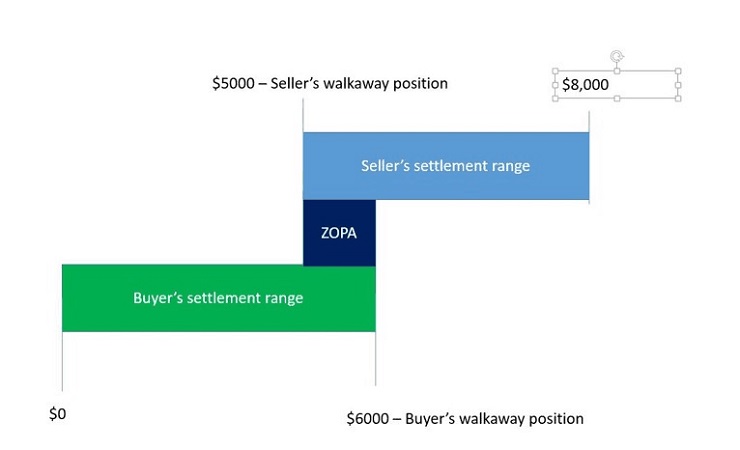Negotiating Like a Champion
Five principles to live by in order to become a master negotiator:
KEY VALUES
- Know Your Worth and Your Value
- Know Where the Other Party Stands
- Keep Your Priorities Straight
- Be Objective and Anticipatory
- Stay Principled
DEFEAT
- Fear of Failure
- Social Awkwardness
- Low Self-Worth
- Poor Discipline
- Leave emotions and egos out
Does the prospect of negotiating with an employer, investor, or business partner make you cringe? Do you shudder at the thought of sitting across a table from someone and driving a hard bargain?
You’re not alone.
In a recent survey, the people over at Salary.com discovered that almost half of the 2,000 individuals interviewed are generally apprehensive when approaching a situation in which they’ll be negotiating the terms of a contract.
While this study dealt strictly with people facing the prospect of negotiating salaries for a job, many in the business world have trouble “getting to yes,” as well. Whether due to a lack of confidence, fear of failure, or a simple lack of negotiation skills, business owners often end up settling for less than they’d like when forging partnerships.
 Getting over your fear of negotiating can pay off in dividends. Source
Getting over your fear of negotiating can pay off in dividends. Source
A lack of negotiation skills and abilities essentially forces you to take what you can get. This leads to you putting more into a business relationship than you get back. In turn, you’re not able to produce or perform to your fullest potential.
On the other hand, being able to effectively negotiate contractual terms and business agreements allows you to get the most out of every relationship you forge (while also performing at maximum capacity). By placing yourself or your company in a position in which you can always put your best foot forward, you increase your ability to get ahead in your industry.
As entrepreneurs, we’re constantly in situations where we need to negotiate the most favorable outcomes for our businesses. This is particularly important for those bootstrapping, or just getting started as entrepreneurs, when margins are razor-thin. Cutting a great deal with a top supplier when you’re setting up an e-commerce store, for example, can be the difference between a successful startup and one that’s just limping along.
Improved negotiation skills also benefit those of us working 9-to-5s while trying to get our businesses off the ground. For instance, you might try to negotiate a raise, or even more flexible hours, during a contract renewal, in turn allowing you to put more capital or time into your business. This benefits you monetarily, but it’s also good practice for when you go all in.
Considering just how important negotiation is to entrepreneurship, it’s a shame so many of us shy away from it. Because it’s not some kind of black magic. Negotiation, like anything else, is a skill that you can learn and get better at.
So to get you started, or give you a boost, the following article will describe five tenets of effective negotiation, including multiple strategies you can implement while following these principles.
But before we dive into these essential principles and strategies, let’s break down exactly how you can benefit from learning how to negotiate properly.
What Can You Gain From Negotiating?
Imagine you could increase your starting salary by $10,000 just by asking.
Or what if you could secure a 25% discount on raw materials from one of your distributors?
Or maybe you think you could get a bit more equity out of a deal with an angel investor.
If negotiating has never been your strong suit, these numbers might seem completely out of the realm of possibility.
But the truth is, getting the people you do business with to agree to such terms is not only possible, with the right negotiation skills, but it’s also actually probable. In fact, in situations involving salaries and other business agreements, the other party usually expects you to negotiate.
We’ll get more into this in a bit. For now, know this:
The simple act of opening negotiations will never be enough to make the other party walk away. If it does, they weren’t the right person to do business within the first place.
5 Proven Approaches to Negotiating Like a Champion
Now that we’ve made it clear how important negotiation skills are in any business setting, let’s discuss five principles to live by in order to become a master negotiator:
- Know Your Worth and Your Value
- Know Where the Other Party Stands
- Keep Your Priorities Straight
- Be Objective and Anticipatory
- Stay Principled
Each of these approaches applies to both the pre-negotiation stage and the act of negotiating. In other words, when implementing the following strategies, you need to be prepared before coming to the table and stay cognizant and conscious while actually sitting down with your counterpart.
1. Know Your Worth and Value to the Industry

Before you even entertain the idea of meeting with a potential employer or business partner, you need to have a clear idea of two things:
- The industry standard regarding your situation
- Where do you stand in comparison to the “average” employee or company
For example, as an individual entering into salary negotiations, you’ll want to know what others in your potential position are earning, both in your area and across the country. Databases such as the US Bureau of Labor Statistics, and sites like PayScale, can help you determine the average salary your position earns nationwide and in your area.
Once you have a ballpark idea of what the average employee in your position earns, you can negotiate for more by differentiating yourself from the herd.
Provide concrete evidence that you deserve more than the median, by using specific examples of your past performance as leverage. If you’ve been offered a position, your interviewer already believes you to be a cut above the rest. Knowing this, you have no reason to settle for a baseline offer.
As a company entering into negotiations for a business relationship, you should also be able to articulate exactly why the other entity should choose to do business with you.
Unlike when negotiating with an employer, a supplier or manufacturer likely has many other qualified potential partners to choose to do business with. Unless they understand that you have something more to offer than these competing companies, they’ll likely take their business elsewhere.
Generally, you can differentiate your company in three ways when it comes to negotiating with a supplier:
- Promising consistency
- Promising longevity
- Promising growth
If the other party trusts they can rely on you to order at least a certain amount of product at regular intervals over a long period of time, they’ll be much more likely to cut you a deal upfront.
You could also discuss with your potential business partner the possibility of ramping up orders in the future. Simply put: the prospect of doing even more business over a longer period of time will absolutely make your company stick out as a prime partner to do business with.
Along with knowing your own worth, you also want to know that you’re getting the most “bang for your buck” when making a business deal.
Consider the following example:
You’re shopping around for a supplier of widgets, and have narrowed the field down to three companies. The one you believe will provide the most value also has the highest price per unit of the three candidates.
You have three options:
You could go with this company and take a monetary loss, but be confident that the business relationship you’ve forged will be long-lasting.
You could go with one of the other two companies and save money, but the future of the relationship will be uncertain.
Or, you could send the first company quotes from the other two, requesting that the company matches one of the lower prices.
Though the first two scenarios aren’t necessarily terrible, the third situation results in you getting the best of both worlds: You get the widgets you need at a discounted price, and you forge a relationship with the company you know will be best for your business.
Here’s a personal story of when this approach worked well for me:
When forming an e-commerce dropshipping business years ago, my main goal was to form mutually beneficial relationships with my suppliers. I knew that doing so would put me in a prime position to negotiate the best possible price for the product I needed.
Before even settling on a supplier, I made a list of my possibilities and ranked them according to my needs. Once I determined which company I wanted to do business with, I contacted them with the goal of seeing if they could match the lower price of one of their competitors.
I provided information regarding my business plan and other data to show how the supplier would benefit from an ongoing relationship with my company. This was all the company needed to agree to my terms.
While I could have theoretically worked with multiple suppliers, I knew that working with one exclusively would allow me to build a relationship and put me in a better position to negotiate further down the road.
So after two months of generating significant sales for myself, and ultimately my supplier, I was able to request a further discount: 5% on small-ticket items, and 25% on bestsellers. Because I had proven myself from the beginning of our relationship, my supplier was more than happy to cut me a deal.
Before we move on, there’s an important lesson in this example I want to make clear:
Negotiating a better deal is never about “getting what you deserve.” It’s about what you can do for the other party that will ease the burden on them, which in turn makes it easier for them to meet your needs in the process.
In other words, negotiation is not just convincing someone to give you what you want, it’s a process of finding mutual benefit.
This brings us to the next principle.
Download Our Exclusive Negotiation Agreement Here
2. Know Where the Other Party Stands

Now that you know what you want to get out of a negotiation session, and you’re clear on what you have to offer to warrant that outcome, you need to know what your counterpart is capable of giving you.
Going back to our salary scenario, although you now should know the average salary of others in your position—and are confident you’re worth more than the average—you should determine the baseline offer for that company ahead of time. Check out sites like Glassdoor to get a better idea of what that specific company can and will offer you.
For business-to-business deals, you’ll want to know as much as you can about what the other party is looking to (or needs to) get out of the agreement.
Similar to the point made in the previous section, you want to be able to provide for these specific needs of your counterpart, with the hopes that doing so will make them waver a bit on their initial position.
There may also be terms that your counterpart simply will not budge on, no matter what you offer to try and sweeten the deal. Find out what these terms are early on, so you don’t waste time or annoy your counterpart by discussing them.
In either case, you’ll want to determine two key factors: your counterpart’s maximum plausible position and their zone of possible agreement.
Maximum plausible position refers to the most beneficial outcome a certain party can reasonably hope for by negotiating. If you’re selling a product or service (or yourself), your MPP would be the highest rate you could justify charging. If you’re on the buyer side of the negotiation, your MPP would be the lowest price you can justify paying (by offering other incentives to the vendor, for example).
In between your MPP and your counterpart’s MPP lies the zone of possible agreement. As the name implies, this is the range of terms that both you and your counterpart would most likely be able to come to an agreement on.
Check out the following graphic for a better understanding of how MPP and ZOPA relate to one another:

Given a ZOPA range of $5-6,000, the buyer’s MPP is $6,000, and the seller is $5,000. Source
Using this example, consider the following scenarios (assuming you are the buyer):
- You offer to pay $1,000 in exchange for the product
- You offer to pay $5,000 in exchange for the product
- You offer to pay $7,000 in exchange for the product
In the first scenario, your offer is almost laughable. Your vendor wants to make at least $5,000 out of the deal; coming to the table with an offer of $1,000 will almost certainly end the negotiation talks immediately.
In the third scenario, your offer is actually way more than your counterpart expected to make. If you come to the table offering $7,000 when they expect to make $6,000 at most, they’re going to accept your offer immediately, no questions asked (and you’ll end up losing money).
The second scenario is the most realistic (to both you and your counterpart). Though the vendor will likely try to get you to go a bit higher, there’s still room to spare in the range of what you consider an acceptable offer.
Another benefit of knowing where your counterpart stands is that you can add “throwaway” terms to your position and “let” the other party get a couple of easy wins.
You might know for certain that the other party won’t agree to x, y, and z terms, and it doesn’t matter to you whether they do or not. But you include these terms in your initial offer anyway, then concede them once your counterpart brings them up (as you knew they would). In turn, the other party feels as if they’ve sweetened the deal on their end, and will be more likely to concede points that you actually care about later on.
When an entrepreneur I know was seeking to raise $2 million of capital, this approach allowed him to do so at the higher valuation that he wanted, while his investor felt like he got a good deal because he was able to negotiate away a lot of the terms that this entrepreneur had added to discussions.
By understanding where your counterpart stands, you put yourself in a prime position to get as much as you possibly can out of a deal, while at the same time ensuring your counterpart feels respected enough by your offer that they’re willing to enter negotiations with you.
3. Keep Your Priorities Straight

You know what you have to offer, and you know what your counterpart can offer. Now you need to be ready to stand your ground.
In other words, you need to determine exactly what you want to get out of a negotiation session—and what you’re willing to give up.
Whether you’re an individual negotiating an employment contract or the head of a company entering into a business agreement, there are two acronyms you need to know:
Your BATNA and your WATNA.
BATNA is short for “best alternative to a negotiated agreement,” and WATNA is short for, you guessed it, “worst alternative to a negotiated agreement.”
Essentially, the BATNA defines the level of value you can get outside of the negotiation at hand. If what your counterpart is offering is lower than this value, agreeing to their terms would result in a loss. On the other hand, if they’re offering more than what you expect to receive elsewhere, anything above the BATNA level is a net gain.
The WATNA is basically the opposite of this—the worst-case scenario. It’s what you stand to lose if you walk away from the table. Generally, the WATNA deals with circumstances of uncertainty: Are you willing to waver on your priorities given the possibility of future losses? Or should you stay focused on your priorities, say no to the deal, and look elsewhere?
Harvard Law provides the following explanation of a BATNA scenario:
“While haggling over a rug in a bazaar, you’re aware that you can purchase an identical rug at a nearby stall for $100. Assuming that you want only one rug, you won’t bargain beyond $100.”
The WATNA version of this scenario might be something like: You don’t know for sure that a competitor sells the rug for cheaper than $100, but you say no when the vendor asks for $110. You then visit the nearby stall and find the same rug being sold for $150. You then go back to the original vendor, who has realized his own error and has changed his asking price to $150, as well.
Of course, this is an oversimplified example of a negotiation scenario; almost all real-world negotiation sessions deal with more than one variable.
Because of this, you’ll want to know which points of an agreement you’re willing to negotiate or waver on (by understanding your WATNA), and which issues you want to stand firm on (by understanding your BATNA).
Consider as many variables as possible before entering into negotiations, then prioritize them. The importance you place on each variable will help you determine whether the terms your counterpart offers fall within your ZOPA, or if you’re better else shopping around for a better deal.
4. Be Objective and Anticipatory
This piece of advice goes along with the main points we’ve discussed in this article: knowing what each party wants and what value can be offered. But knowing initial intentions is only the beginning of creating an effective negotiation strategy.
To take your negotiation skills to the next level, you’ll want to anticipate how the entire session will play out.
Just as a good chess player can read how the game will unfold in response to a given move, a good negotiator can get a sense of how their initial terms will unfold in real life.
This requires you to be as objective as possible, removing any biases you may have toward your own cause. In short, you’re trying to determine how your hypothesis will stack up to reality.
First, assess the validity of the offers you plan to make. Will doing x really add y value to your counterpart’s business? Is what you’re asking for, and what you’re giving up, really an even trade? Will you truly be able to follow through with your end of the bargain, or are you making promises you can’t keep?
The answers to these questions may be simple, or they may be nuanced. Determine the degree to which you’ll be able to live up to your side of the agreement, and you’ll be in a much better position to anticipate how the deal will play out.
But there’s still more prep work to do before you meet up with your counterpart.
After you’ve determined your course of action, try to figure out possible “plays” the other party might make throughout your discussions. Anticipate arguments, counterarguments, questions, and concerns they might pose at different points throughout the conversation. This will not only help you prepare rebuttals that could further your cause, but it could also help you pinpoint weaknesses in your argument that might leave your counterpart with the upper hand.
If possible, conduct mock negotiation sessions with a peer, colleague, or business partner to put your knowledge into action. After practicing your end of the argument, take on the role of your counterpart. This will help you remain objective and allow you to further identify shortcomings in your own argument.
Covering all the bases before you enter into a negotiation session can increase your confidence in your own abilities. In turn, this confidence will allow you to shoot straight for what you’re looking to get out of the conversation.
It’s also important to anticipate what elements in the discussion you might be overlooking.
When negotiating a partnership or joint venture, sure you’ll negotiate on terms, but it’s also important to negotiate on marketing objectives and other key metrics upfront. What do you want to see happen over the next month, quarter or year to deem the partnership successful? Is it a number of leads? Customers? Revenue?
Also, what are YOUR expectations of your partner? If it’s important the partnership launches by a specific date, make sure you discuss and negotiate that upfront. I can’t tell you how many partnership deals I’ve seen that start out well but end horribly because there was no upfront discussion around timeframe and launch expectations.
Download Our Exclusive Negotiation Agreement Here
5. Stay Principled

As you approach a negotiation setting, it’s important to remember two things:
- Always look for the win-win situation
- Leave emotions and egos out of the equation
We might also rephrase this principle as “don’t be a jerk.” You may have noticed that we never once referred to your counterpart as your “opponent.”
That’s because they aren’t. When you’re negotiating the terms of your salary, you’re doing so with a prospective employer. When you’re negotiating the terms of a business agreement, you’re working with a potential partner. These individuals are not your enemies.
So while your goal when negotiating is to receive the best deal possible, you don’t want to cheat your counterpart out of anything while doing so.
Instead of trying to pull them over to your side, meet somewhere close to the middle. Instead of looking for a quick win, think long-term, mutual gains. Rather than trying to squeeze maximum value out of your counterpart for minimum effort on your end, put your fair share in the middle so you both can reap the rewards.
Regarding emotions, it may be difficult to keep your ego in check during the heat of the moment, but you simply must. Allowing emotions to get in the way of making a conscious business decision will make it clear to your counterpart that you’re flustered and unprepared, or it could drive them away completely.
If you don’t get exactly what you want out of part of the deal, don’t think of it as a defeat. Conceding one area in the interest of allowing the complete deal to go through is not just a professional victory, it’s a win for your ego, as well.
Good Negotiation Skills Can Propel Your Business
Negotiation skills can help you in pretty much every area of your life.
While persuading your significant other to let you have a night out with your friends is rather inconsequential, when it comes to your career or your business, they can make a real difference. With these skills, you can set your business up for long-term success. Without them, you may end up missing out on invaluable potential gains.
How have you successfully used negotiation skills in your career or business? What gains did you achieve? Any questions on negotiation I can answer? Let us know in the comments below!























